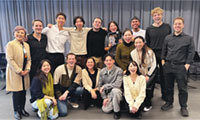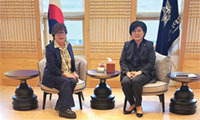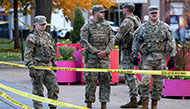Bangudae Petroglyphs in the modern Korean Poems
My friend and poet, Lee Geon-chong, organized a unique poetry-art show as a campaign to educate people for protection and preservation of the Bangudae Petroglyphs. I am honored to join 35 other poets he invited for their new poems match-able to significant art works in the rock panels, whales and animals in the petroglyphs. The exhibit of poetry-art ensemble is going to the public in the Bangudae Petrophyphs Educational Center near Bangudae. Senior Korean poetess Kim Nam-jo participated with her poem on whales. My poem is Wolf.
The organizing committee assigned wolf to me. All poets who participated in this exhibit should calligraphy their poems with their own blushes with black ink on rice paper. I am only poet outside Korea due to my environmental policy advocacy role. As a matter of fact, I introduced his poetry book , In Front of Bangudae Petroglyphs, to the Korea Times years ago. I have been signaling the danger of this pre-historic cultural heritage for the human kind to the United States , but in vain so far. I have been still trying to reach the Smithonian Institution and the National Geographic to the Bangudae Petroglyphs. We, as human beings, should protect our historic heritage beyond the national boundary line.
I traveled to Peru and saw Nazca Lines and Petroglyphs. From the trip, I produced a series of poems from Peru which included Nazca Line published in the Literature Consciousness in its winter issue of 2015. Nazca Line was a mysterious art work on the Peru desert land. It could only be seen from sky, so I took Cessna to see it from above. It attracted tourists from the world. Archeologists and anthropologists estimated that the Nazca Line was drawn 2000 years ago as a possible religious service of Nazca people to God. A hummingbird, a spider, a killer whale, flowers, trees and an astronaut-looking man were among the twelve petroglyphs figures. One long line was 20 km. Total length of lines and curves made more than 1000 km. Why they were drawn in the desert is only guessable, disputable, and will remain so.
Bangudae art works are known as 6000-7000 years old. Some said they were done between 6000 and 3500 years ago. Unlike Nazca, there was no known civilization around Bangudae. However, I can imagine that Bangudae was where a river met the sea where all kinds of wild animals flourished and later human beings settled down. Whales were there long before human beings appeared on the Earth. The Bangudae art works are more than whales; all kinds of sea and land wild animals and fish. But whales and whale hunting boats and tools attracted most of our attention.
Rock arts are 304 on a group of rocks on a branch of River Taewha flowing into the East Sea. The engravings of whales, deer and wolf were made in most cases by carving out the body, while those of land animals mostly consist of outlines and patterns drawn on the rock surface. The human figures are side views of the whole body with a somewhat exaggerated penis or front images of people with mask-like faces spreading their four limbs. There are engravings of people hunting animals with a bow, raising their hands, and playing a long rod like a musical instrument, recalling hunting and religious acts.
Bangudae petroglyphs are a collection of stone-aged men’s life in the seacoast wilderness, but their whaling is the masterpiece on the rock arts. Whales must be their major source of food, oil and other necessary nutrition.
My poetic imagination naturally extends to Namsan, Kyungju, South Mountain of Kyungju, where all kinds of Buddha were engraved on the mountain rocks by Silla people between the sixth to ninth century. The mountain as a whole is a museum.
Who knows? Silla Kingdom was originated from Bangudae and advanced by whale hunters to Kyungju. But I am sure Bangudae people were the first whale hunters of human history. Most probably, this site was the worship place of the prehistoric people for harvesting whales and other sea and land animals. We have to explore the lost civilization around Bangudae. Whale is a common figure in the seaside Bangudae and desert Nazca Petroglyphs, strange to say, at the least.
I wrote my own Bangudae Petroglyphs before. Here is my poem in English.
Bangudae Petroglyph
The prehistoric people engraved their activities on the stone face, The petroglyph.
They lived in a settlement,
Domesticating wild animals in the wooden fences,
Whaling in the sea from a boat with harpoons and nets,
And, then they carved whaling excitement on the stone surface.
Their wisdom created the first whaling act in the history of mankind,
Helped their sea-bound life to be richer.
The East Sea must have been the very first whale fishery.
The whaling offered them vital nourishment as well as lighting lamp oil.
These particular petroglyphs revealed that the first human settlement was just where the river met the East Sea.
A thousand years later the people of the Silla Kingdom sculptured an image of the Buddha in the grotto.
Bangudae petroglyphs turned out to be so unique in the cultural heritage, nowhere else can be seen.
The practice of carving in the dark cave reached the shore of the Atlantic Ocean many centuries later.
The vitality shown by the early whalers is still afresh
Although it has been being washed by the waves over and over.
They are asking now who hunted the whale to the danger of extinction, the precious species.
We cherished the sea as our own front yard,
Loved a whale pod,
Did not overfish them,
Treasured the scenery of the shore and the art of engraving.
We still claim those as ours.
<By Yearn Hong Choi >
스마터리빙
more [ 건강]
[ 건강]이제 혈관 건강도 챙기자!
[현대해운]우리 눈에 보이지 않기 때문에 혈관 건강을 챙기는 것은 결코 쉽지 않은데요. 여러분은 혈관 건강을 유지하기 위해 어떤 노력을 하시나요?
 [ 건강]
[ 건강]내 몸이 건강해지는 과일궁합
 [ 라이프]
[ 라이프]벌레야 물럿거라! 천연 해충제 만들기
 [ 건강]
[ 건강]혈압 낮추는데 좋은 식품
[현대해운]혈관 건강은 주로 노화가 진행되면서 지켜야 할 문제라고 인식되어 왔습니다. 최근 생활 패턴과 식생활의 변화로 혈관의 노화 진행이 빨라지고
사람·사람들
more
창작 뮤지컬 ‘도산’ 웍샵
창작 뮤지컬 ‘도산’이 뉴욕 맨해튼에서 미국배우조합 리딩 웍샵을 성공적으로 마쳤다. LA 무대예술인그룹 시선(대표 클라라 신)이 제작한 이 작…

“한국어 교육 확산 협력”
한국어진흥재단(이사장 모니카 류)이 숙명여대(총장 문시연)와 한국어 교육 확산을 위한 협력에 나선다. 한국어진흥재단의 모니카 류 이사장은 지난…
송년행사 시즌 ‘돌입’ 12월 첫 주부터 본격
추수감사절 연휴를 기점으로 남가주 한인사회가 본격적인 송년행사 시즌에 돌입한다. 한 해를 마무리하고 새해를 준비하기 위한 각 단체·동문회의 연…
KYCC·VWKC·주민의회 등 합동 타운 대청소 …
한인타운청소년회관(KYCC)과 헤더 허트 시의원(LA 10지구) 사무실, 그리고 행사에는 윌셔 한인타운 커뮤니티 목소리(VWKC), 내셔널 유…
ROTC 남가주 동지회 골프 모임
ROTC 남가주 동지회(회장 이창훈)는 지난 22일 라미라다 골프코스에서 골프 모임을 열었다. 이날 행사에는 30여 명이 참석해 라운딩을 함께…
많이 본 기사
- 추수감사절 ‘포식’, 심장에는 위험 신호 될 수 있다
- 인간의 경쟁자 될까, 든든한 동료 될까… ‘휴머노이드의 진화’
- 이민 구금자수 역대 최다… 단순 체류위반 20배 폭증
- 한인 2세 지나 권씨 주정부 장관에
- 이병헌, 레오나르도 디카프리오·티모시 샬라메와 나란히..美시상식 후보
- 유동근♥전인화 CEO 딸, 방송 최초 출연.. “미모? 공들인 얼굴”
- 트럼프 “백악관 앞 총격은 테러”… 반이민 강화 고삐
- 국민연금 증명 편리해진다 온라인 아포스티유 발급
- JP모건, ‘S&P 500 목표가 8,000P’
- BTS 정국, 솔로곡 스포티파이 누적 재생수 100억회 달성
- 극단적 선택 시도 고백 후..MC몽, 이번엔 사기 피해 당부
- 연말을 향해 달리는 불빛의 궤적
- 이용대, ♥윤채경 열애설 질문에 당황.. “넘어가 달라”
- 경찰관이 근무 중 도둑질 차량 수색하며 현금 꿀꺽
- 401K 비차별 테스트 준비
- 홍콩 77년래 최악 화재… ‘대나무 비계’타고 불길 번졌다
- 오바마케어 보조금 연장 이뤄져야
- 집값 상승에 ‘투자 대이동’… 중산층 절반 이상이 ‘주식’
- ‘이강인 교체 투입’ PSG, 토트넘 5-3 격파
- 아마존, 사기 급증 경고 연말맞아 회사 사칭 극성
- LA 주차위반 단속 강화… 티켓 발부… 1
- 일주일 강수량이 무려 1.8미터… 동남아 ‘물폭탄 비명’
- [역사 속 하루] 태즈메이니아 섬 발견, 비극의 시작
- 리듬과 시조, 미래의 언어
- LA 주민 3분의 2 “카운티 잘못된 방향 간다”
- 겨울철 심장 관리… 오메가3·크릴오일 질환 예방 효과 ‘글쎄’
- 추수감사절 연휴 맞아 LA 오토쇼 관람 인기
- [이런 일도] ‘인간 세탁기’ 나온다
- 개인적 상처를 판타지로 승화시킨 감독의 용기
- ‘중견 작가들이 선보이는 따뜻한 감성’
- 샤토갤러리 ‘팝업 X-마스 마켓’
- 증시, 연휴 휴장·반장 오늘 오후 1시까지만
- ‘도우인 메이크업(중국식 메이크업)’ 붐 타고… 동남아·일본 등 폭풍성장
- [마크 A. 시쎈 칼럼] 트럼프 승리를 파괴하는 백인 우월주의자들
- 트럼프 행정부, 올해 연방 공무원 32만명 감원
- 송성문 행선지로 다저스·샌디에고 예상
- UC, 등록금 인상 자제 노력 더 해야한다
- ‘오픈AI’ 분석 파트너사 해킹 당해
- “고용 소폭 감소… 노동수요 약화”
- “반갑다 집값 둔화”… 5개월 연속 90만달러 밑돌아
- “캠벨수프 소비자는 빈곤층” 발언 논란
- [한국춘추] 감사의 힘
- [전익환 프로의 골프교실] 백 스윙의 몸 동작
- [주말 뭐 볼까 OTT] ‘진정한 사랑은 자본주의가 빼앗을 수 없다’… 사랑의 진짜 가치는?
- 한진그룹, 미군 참전용사단체 후원
- 트럼프 관세발 물가… ‘정책 유턴’ 신호탄?
- ‘5년내 유료구독자 2억2,000만명’
- [만화경] AI 거품론과 ‘그린스펀 오판’
- 제주에서 수출한 일본판 ‘올레’… 1300년 전 길을 걷다
- [LA 왕발] “따뜻하고 든든한 한 끼… 최고의 맛”
1/5지식톡

-
 테슬라 자동차 시트커버 장착
0
테슬라 자동차 시트커버 장착
0테슬라 시트커버, 사놓고 아직 못 씌우셨죠?장착이 생각보다 쉽지 않습니다.20년 경력 전문가에게 맡기세요 — 깔끔하고 딱 맞게 장착해드립니다!장착비용:앞좌석: $40뒷좌석: $60앞·뒷좌석 …
-
 식당용 부탄가스
0
식당용 부탄가스
0식당용 부탄가스 홀세일 합니다 로스앤젤레스 다운타운 픽업 가능 안녕 하세요?강아지 & 고양이 모든 애완동물 / 반려동물 식품 & 모든 애완동물/반려동물 관련 제품들 전문적으로 홀세일/취급하는 회사 입니다 100% …
-
 ACSL 국제 컴퓨터 과학 대회, …
0
ACSL 국제 컴퓨터 과학 대회, …
0웹사이트 : www.eduspot.co.kr 카카오톡 상담하기 : https://pf.kakao.com/_BEQWxb블로그 : https://blog.naver.com/eduspotmain안녕하세요, 에듀스팟입니다…
-
 바디프렌드 안마의자 창고 리퍼브 세…
0
바디프렌드 안마의자 창고 리퍼브 세…
0거의 새제품급 리퍼브 안마의자 대방출 한다고 합니다!8월 23일(토)…24일(일) 단 이틀!특가 판매가Famille: $500 ~ $1,000Falcon: $1,500 ~ $2,500픽업 & 배송직접 픽업 가능LA…
-
 바디프렌드 안마의자 창고 리퍼브 세…
0
바디프렌드 안마의자 창고 리퍼브 세…
0거의 새제품급 리퍼브 안마의자 대방출 한다고 합니다!8월 23일(토)…24일(일) 단 이틀!특가 판매가Famille: $500 ~ $1,000Falcon: $1,500 ~ $2,500픽업 & 배송직접 픽업 가능LA…
케이타운 1번가
오피니언

오바마케어 보조금 연장 이뤄져야

UC, 등록금 인상 자제 노력 더 해야한다
 마크 A. 시쎈 / 워싱턴포스트 칼럼니스트
마크 A. 시쎈 / 워싱턴포스트 칼럼니스트 [마크 A. 시쎈 칼럼] 트럼프 승리를 파괴하는 백인 우월주의자들
 유경재 나성북부교회 담임목사
유경재 나성북부교회 담임목사 [한국춘추] 감사의 힘
 김인자 시인·수필가
김인자 시인·수필가 [금요단상] 장미의 이름, 진리의 이름
 최호근 / 고려대 사학과 교수
최호근 / 고려대 사학과 교수 [역사 속 하루] 태즈메이니아 섬 발견, 비극의 시작
 최형욱 / 서울경제 기자
최형욱 / 서울경제 기자 [만화경] AI 거품론과 ‘그린스펀 오판’
 조재성 LA 포럼 회장·도시비평가
조재성 LA 포럼 회장·도시비평가 [조재성 박사의 두 도시 이야기] 코리아타운, 불완전함의 아름다움
 김재천 서강대 국제대학원 교수
김재천 서강대 국제대학원 교수 [김재천 칼럼] 경제로 안보를 사는 시대
1/3지사별 뉴스

정혜선한국전통예술원 ‘아리랑-동방의 울림’공연 성황
정혜선한국전통예술원의 특별공연 ‘아리랑-동방의 울림’(Arirang-Echoes of the East)이 지난 23일 전석 매진속에 뉴저지 포…
오바마케어 보조금 2년 더 연장되나

“에어프레미아, 내년 3월 워싱턴 취항”
신생 항공사인 에어프레미아(Air Premia, 사진)가 내년 3월부터 인천과 워싱턴 덜레스 공항을 정기운항할 것으로 알려져 관심이 쏠린다.한…
마이클 박 연방 판사 ‘유력한 대법관 후보자로 급부상’

트럼프 “총격당한 주방위군 병사 2명 중 1명 사망”
도널드 트럼프 대통령은 27일 아프가니스탄 출신 이민자로부터 전날 워싱턴DC의 백악관 인근에서 총격을 당한 주방위군 병사 2명 중 1명이 사망…
피아니스트 조성진, 내년 1월 SF에 온다

오늘 하루 이 창 열지 않음 닫기 


















































.png)


댓글 안에 당신의 성숙함도 담아 주세요.
'오늘의 한마디'는 기사에 대하여 자신의 생각을 말하고 남의 생각을 들으며 서로 다양한 의견을 나누는 공간입니다. 그러나 간혹 불건전한 내용을 올리시는 분들이 계셔서 건전한 인터넷문화 정착을 위해 아래와 같은 운영원칙을 적용합니다.
자체 모니터링을 통해 아래에 해당하는 내용이 포함된 댓글이 발견되면 예고없이 삭제 조치를 하겠습니다.
불건전한 댓글을 올리거나, 이름에 비속어 및 상대방의 불쾌감을 주는 단어를 사용, 유명인 또는 특정 일반인을 사칭하는 경우 이용에 대한 차단 제재를 받을 수 있습니다. 차단될 경우, 일주일간 댓글을 달수 없게 됩니다.
명예훼손, 개인정보 유출, 욕설 등 법률에 위반되는 댓글은 관계 법령에 의거 민형사상 처벌을 받을 수 있으니 이용에 주의를 부탁드립니다.
Close
x